The main reason I write about dynamic drivers and balanced armature drivers is to raise awareness of the small units hidden inside attractive earbuds and headphone cases.
The two main sound reproduction technologies used in earbuds and in-ear monitors (IEMs) are dynamic drivers and balanced armatures.
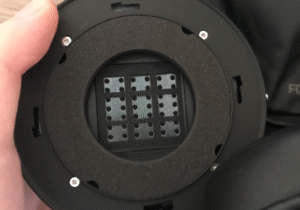
Both technologies are devices that produce sound similar to small speakers in many ways. The differences in their construction also result in different ways in which the frequency response is distorted.
Balanced Armature vs Dynamic Driver?
About balanced armatures (BAs)
A balanced armature consists of a coil surrounding the armature. This coil is suspended between two magnets.
When current passes through the coil, the change in current causes a vibration between the magnets and the coil.
The change in magnetic field causes the armature to vibrate about 1,000 times per second. The diaphragm connected to the armature moves, generating sound waves.
This particular method is most effective at targeting a specific frequency range and can be tuned to the desired frequency range using a crossover method.
Basically, this crossover splits the sound signal into multiple frequency lines, which are then sent to multiple drivers. This is why IEMs tend to use multiple drivers to extend the frequency response.
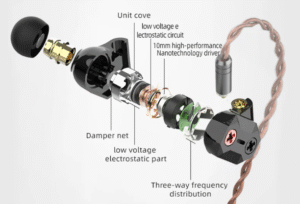
Balanced armature drivers are called “balanced” because there is no net force on the armature when it is centered in the magnetic field.
Therefore, balanced armatures are more effective at blocking sound. This design also consumes less power than dynamic drivers.
Pros and Cons of Balanced Armature Drivers
Balanced armature drivers are smaller than dynamic drivers, making them ideal for use in smaller devices such as earbuds, in-ear monitors, and hearing aids.
Because they are smaller, multiple drivers can be installed in a single earpiece, adding more detail and clarity to the sound produced by these devices.
Additionally, these drivers are tuned to operate at specific frequencies, which improves high-quality sound and ensures better frequency response across the entire audible range.
As mentioned earlier, balanced armature devices do not have vents, which makes them more effective at blocking sound.
They also consume less energy to produce a loud sound, which can reduce power consumption or battery life, depending on the type of device.
About Dynamic Drivers
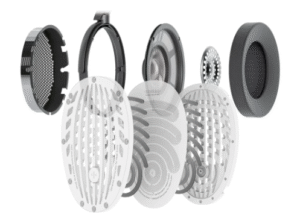
Dynamic drivers are widely used in earbud-type earphones. They are similar in structure to small speakers, with a voice coil driving a membrane like a small speaker cone.
Of course, the size and mass of the membrane being driven determine the overall frequency response. Dynamic drivers are very efficient and do not require much input to produce high volumes.
Dynamic drivers are better at covering the entire frequency range. Dynamic drivers are made with a voice coil attached to a diaphragm.
When current flows through the driver, the voice coil between two magnets vibrates, causing the diaphragm to move, which in turn produces sound.
The air passing through the dynamic driver actually provides better bass expression, and overall, a more natural and cohesive sound.
In-ear earphones with dynamic drivers can typically be slightly larger than those with balanced armature drivers.
This larger size improves the bass response of the earphone, providing punchy bass, but tends to be somewhat reduced in the high frequencies.
So if you want rich bass rather than a somewhat flat frequency response, you might want to consider IEMs with dynamic drivers or earphones that combine dynamic drivers with one or more balanced armature drivers.
Pros and Cons of Dynamic Drivers

In short, dynamic drivers are very inexpensive, which can save you money on your earphones/headphones. They last a long time and don’t require a lot of power to produce very loud sounds.
Dynamic drivers are usually described as having warm, rich bass and are very popular with musicians such as drummers and bassists.
However, they can be tuned in a variety of ways, and some high-end models can deliver audiophile-quality sound with amazing balance and clarity.
The downside is that these drivers don’t produce a very detailed sound and tend to distort at high volumes.
This only applies to the most basic models, but I think it’s worth mentioning. Furthermore, dynamic drivers can be quite large, which can add bulk to the device.
Conclusion: Balanced Armature vs Dynamic Driver? Which is better?
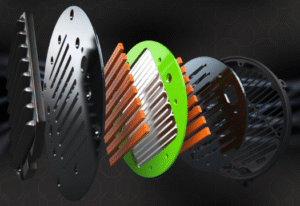
Knowing the driver configuration of your earphones or in-ear monitors can help you make your choice.
If you prefer a flat response across the audio spectrum, consider a phone with one or more balanced armature drivers.
Depending on the manufacturer, these types of phones are usually in-ear monitors and can contain up to eight balanced armature drivers.
If you want more powerful performance in the low end, you can consider a model that uses dynamic drivers or a hybrid model that uses both types of drivers.
Since balanced armatures require more drivers to provide better performance across a wider range of the frequency response range, these IEMs tend to be more expensive than dynamic drivers.
Balanced armatures offer greater clarity in this regard. However, they perform better in the high-end.
Dynamic drivers, on the other hand, lack the subtle detail but offer a warmer, more consistent tone and wider bass range.
Dynamic drivers are usually larger than BA drivers, so you’ll need to consider a larger earbud housing.
However, you don’t have to rule out the possibility of having both. There are models that offer both.
Check Price For Balanced Armature
Check Price For Dynamic Driver
FAQs
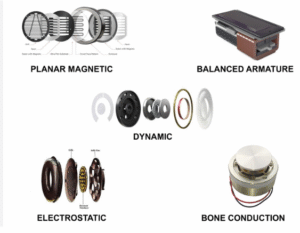
What is a driver?
A driver is a small speaker unit made up of a magnet, a voice coil, and a cone-shaped diaphragm, and has the single purpose of converting an electrical signal into sound waves that the human ear perceives as sound.
The drivers vary depending on the type of headphones, in-ear monitors, hearing aids, or speakers you’re using, and the sound signature the manufacturer is aiming for.
Drivers can be single-driver, which means one driver is installed in each earpiece, or multi-driver, which means there’s enough space to install multiple drivers.
In terms of driver size, earbuds come with drivers ranging from 8 to 15 mm, while headphones come with drivers ranging from 20 to 50 mm.
Of course, speaker drivers can be much larger, depending on the size of the speaker and its intended use. Regardless of size or purpose, all drivers follow the same operating principle.
All the sound we hear is actually compressed air in the form of sound waves. It is caused by vibrations generated by every object or living thing on Earth.
All drivers on the market produce sound as a result of these vibrations, and this is what all drivers have in common.
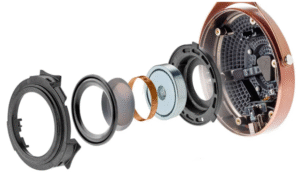
Are dynamic drivers better than balanced armature drivers?
In conclusion, balanced armature drivers produce a more detailed sound. Dynamic drivers provide a more consistent and powerful sound, often described as a “warmer sound.”
Some manufacturers even offer hybrid models that combine the unique characteristics of balanced armature and dynamic drivers.
Are dynamic drivers better?
When current flows through the driver, the voice coil between the two magnets vibrates, causing the diaphragm to move, which in turn creates sound.
The movement of air through the dynamic driver enhances the low-frequency expression and creates a more natural and cohesive sound.
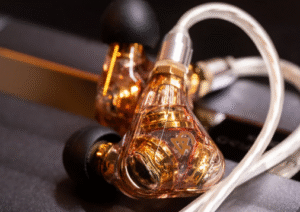
What is a balanced armature driver?
Balanced armature drivers vibrate a small reed balanced between two magnets in a small case, which is then converted into an electronic signal.
The movement of the reed is transmitted to a very rigid aluminum diaphragm. This diaphragm has no unwanted resonances in the audio band, which provides excellent clarity.
Also read: Do Headphones Cause Hair Loss?
